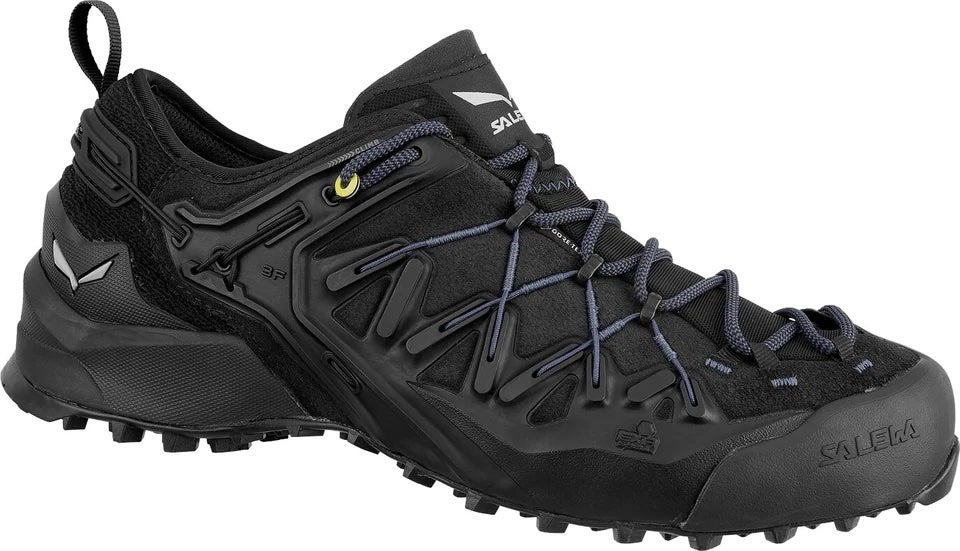Review: Salewa Wildfire Edge Approach Shoe

Footwear is a magnet for flashy gimmicks that sound “technical” but don’t actually affect performance. So when I read about the 3F System (aka the Switchfit adjustment—more on this below) that converts the Salewa Wildfire Edge approach shoe from “hiking mode” to “climbing mode,” my inner skeptic grinned.
The 3F System is essentially two thin cords connecting the top eyelets, the sole, and the back of the shoe above the heel. It’s a simple design that, combined with laces that extend to the toe, makes a big difference in fit and control when edging and smearing by forcing your foot forward, noticeably improving security on technical terrain. Yet as my smiling skeptic anticipated, the system is “activated” by—wait for it—tightening the shoelaces. Cinch them up (starting from the toe) and BAM!—you’ve converted the Wildfire Edge to “climbing mode.” To convert back to “hiking mode,” simply loosen the laces until the shoes feel comfortable for walking.
Advertised as sticky in wet or dry conditions (which I did not encounter during the heavy winter and rainy spring we had in the American Southwest), the Pomoca Speed MTN rubber outsole is, in reality, only so-so for climbing. The insole incorporates a stiff Edging Plate under the forefoot and smooth rubber (for climbing) between the big toe and ball of the foot, which offered me stability for boulder-hopping steep granite in Boulder Canyon. But when I tried to smear and edge up 5.4 slabs in the Flatirons, I immediately changed into actual rock shoes. That’s partly my own preference for sensitivity, and partly the fact that the Pomoca Speed MTN just isn’t nearly as sticky as other compounds I’ve tested on approach shoes. That said, I appreciated the outsole’s durability and aggressive tread for superior traction on the many muddy and slushy trails I hiked in these babies.
At 828 grams (1.83 pounds) per pair (US 9), the Wildfire Edge is on the heavier side of average for low-top approach shoes. One benefit of its weight is sturdiness in the form of its Exa Shell—a low-profile rubber exoskeleton that provides torsional stability as well as protects the laces and uppers (1.6 millimeter suede with a mesh lining) from excessive wear. After a dozen days of hiking and scrambling in Colorado, the Exa Shell is scuffed—having done its job shielding the uppers—but is in otherwise fine shape.
The Wildfire also comes equipped with the MFF+ (Multi Fit Footbed Plus), a removable footbed made of two thin (~2 millimeters), foam-like parts attached with Velcro. The customizable footbed allows for three possible arrangements that you can fine-tune to your foot shape, with a slight increase or decrease in volume, depending on what’s most comfortable. I imagine most people will do as I did and leave the footbed as-is, with the most material underfoot, because the difference between options seemed relatively minor. I normally sport a US 9.5 or 10 in approach shoes, and I tested a US 9 Wildfire Edge. My wide forefoot feels as tight as I’m willing to go, but overall this size fits remarkably well. If scrambling and technical approaches are your priority, consider trying a half-size smaller than usual.
Incredibly, Salewa offers a 100 percent blister-free guarantee with many of their shoes, including the Wildfire Edge. No blisters here! (Thankfully, me and my skeptic don’t have to navigate the redemption of this guarantee…). Overall, this sturdy shoe shines on rough trails and steeper, class 4 terrain, like you’ll find in the Tetons, Rocky Mountains, or the Cascades. Of course, it’s also a “shoe-in” for hiking to your everyday crags.
$170, salewa.com (men’s | women’s)